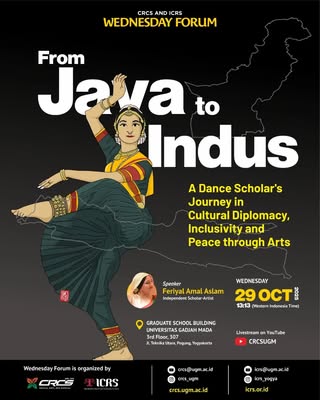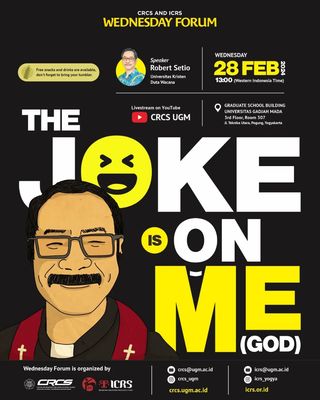
This article is written by Hanny Nadhirah (M.A. student at CRCS, UGM) based on a research trip to Kali Code as part of "Religion and Ecology" class.
“How does it feel to live in an area that used to be unlivable?” This is a story about Kali Code, a legendary settlement on the side of a river called Code, in Yogyakarta. Known for its complex waste and pollution problems, Kali Code is a markedly different in 2024.
Upon entering Kali Code, the area was very clean, with little to no litter that is usually found in typical neighborhoods in Indonesia. The scenery reflects the commitment of the Kali Code community to address the issue of waste management, especially through its collaborative work on bank sampah (waste bank). In Kali Code’s bank sampah, the residents collect their household waste, ranging from plastics to used cooking oil. As a result, this system has effectively managed the waste in the Kali Code neighborhood, especially during Yogyakarta's current trash crisis.
The community's initiatives extend beyond waste management. The Merti Code, a ceremony, is another powerful embodiment of the dedication to preserving the environment. The word ‘merti’ is a Javanese word that means to keep and maintain. The ceremony draws inspiration from Javanese tradition, while also engaging people of different faith backgrounds. As a result, aside from raising awareness about river sustainability, this annual ceremony also fosters a sense of diversity among local residents and society in general. Therefore, this duality of purpose in the Merti Code ceremony reminds us of Bruno Latour's concept of hybridity.
From Kali Code to Bruno Latour's Hybridity Concept
Bruno Latour is a French philosopher and the author of We Have Never Been Modern (1993). According to Latour, modernity is about the separation of nature and society, which is also extended to the tradition of defining phenomena within rigid categories. For example, we are used to thinking that humans and nature are two separate entities or that science and politics are also usually seen as having different objectives (Blok & Jensen, 2011). Latour argues that the world is always hybrid, where every entity is interdependent on one another. As a result, Latour proposed that we should avoid fixed binary categorization, especially in relation to nature and society (Blok & Jensen, 2011). Therefore, Latour’s thoughts are very relevant in assessing the neighbourhoods, Merti Code, and human-nature relations of the Kali Code communities.
First, what comes to mind when we hear the word ‘nature’? Is nature a distinct entity from humans, or are humans a part of nature? Then, what qualifies as ‘natural’? Most of the time, when we say ‘nature’, we refer to the river, trees, mountains, and others. On the contrary, when we say the word ‘neighbourhood’, it is discussed as if it only of human-made landscapes such as houses, commercial buildings, schools, and public infrastructure. However, reflecting on the Kali Code neighborhood, there is a multifaceted interplay between a purely ‘natural’ environment and a purely ‘human-made’ environment. In Kali Code, we see how the houses and buildings are very close to the river. The human-made landscape significantly impacts the river and the river also influences the buildings surrounding it. They cannot exist separate from one another, the interconnectedness has always been there. The lifestyle of the local community and the river’s dynamics are constitutively shaping each other's presence. On one hand, if the Code River were not there, the existing Kali Code community would not be as we can see right now. On the other hand, if the current residents of Code River did not consist of an existing community now, the river would have experienced a whole different set of dynamics. Excluding the extra-human elements (like rivers, forests, or mountains) will miss the complexity of reality. Therefore, the rigid binary categorisation between ‘natural’ and ‘human-made’ neighbourhoods is not relevant.
Second, the Merti Code annual ceremony also resonates with Latour’s hybrid concept. On one hand, the Merti Code is seen as a sacred ritual that is rooted in Javanese traditions. The Merti Code involves ceremonial processions that collect spring water from the ‘Seven Sources’ on the slopes of Mount Merapi, the Boyong River, and the Code River. There are also other symbols involved, like enceh (pot) and Tumbak Kyai Ranumurti (spear), that bear cultural significance and sacredness just like other rituals in Yogyakarta (Asri, 2023). As a result of the Code River’s sacredness, which this ceremony emphasizes, they aim to convey a message about environmental preservation. However, on the other hand, there are also people who see the Merti Code as a mundane activity that is part of tourism promotion. They view the Merti Code as part of a local festival where they can preserve cultural heritage while attracting more tourists to Yogyakarta. In other words, we can see Merti Code’s hybridity in spirituality and pragmatism, which consistently interplay. The spiritual dimension highlights the urgency of maintaining the ceremony because it bears significance to respect the river. Meanwhile, the pragmatic dimension supports facilitating more participation every year so that the tourism industry can thrive. Therefore, the dual nature of the Merti Code reflects Latour's concept of hybridity.
Understanding Hybridity: A Lesson for Human-Nature Relations
Why is Latour’s hybrid concept so important for us to discuss? The question finally brought us to the most important point, rethinking human-nature relations. Reflecting on the previous two discussions about Kali Code’s neighborhood and Merti Code, they resonate with Latour’s concept of hybridity, where we cannot put strict division between two seemingly different entities. In this regard, the blurred distinctions eventually challenge our mainstream understanding of human-nature relations. In the past, we used to learn that humans are different from nature and that humans can dominate nature. Or maybe we are still very familiar with the anthropocentric discussion, where we place priorities only in the human’s interest and perspective. While it may seem true for many people out there, this is not the case. Reflecting on the case of the Kali Code, we see how humans and nature are deeply intertwined, to the point that it is very hard to impose a rigid separation between them. If we argue that we are not a part of nature, then how do we explain our buildings that are built on the land, our foods that depend on natural resources, and our water that is from rivers? Denying that we are distinct and not a part of nature overlooks the fact that we have always lived in a hybrid relationship with nature. Thus, to make our environment livable, reflecting on the Kali Code, we must ensure that both human and extra-human elements are respected and preserved harmoniously. With that, we can work towards creating sustainable and relational environments for all.









